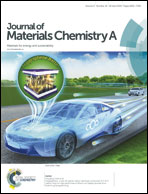A CO2-responsive graphene oxide/polymer composite nanofiltration membrane for water purification†
Abstract
A “smart” graphene oxide (GO) based nanofiltration membrane was prepared through electrostatic and π–π interaction-driven complexation with poly(N,N-diethylaminoethyl methacrylate) bearing a pyrene end group (Py-PDEAEMA). The composite membranes show a number of attributes potentially appealing for water treatment. First, they display reversible, gas-tunable water permeability between the pore closure state under CO2 stimulation and the pore opening state upon Ar bubbling. The water permeability remains much higher than that of a pure GO membrane even at the pore closure state. Secondly, the separation of organic dye molecules from water using this membrane is similarly efficient as that using a pure GO membrane despite the much higher water permeability. Finally, as a result of CO2-induced reversal of the charge sign, the composite membrane shows an excellent trade-off between rejection of some salts like MgCl2 and water permeability, with both much higher rejection and permeability compared to a pure GO membrane. This study of a CO2-responsive, GO-based nanofiltration membrane, the first of its kind, demonstrates new perspectives in developing smart separation membranes for water purification.



 Please wait while we load your content...
Please wait while we load your content...